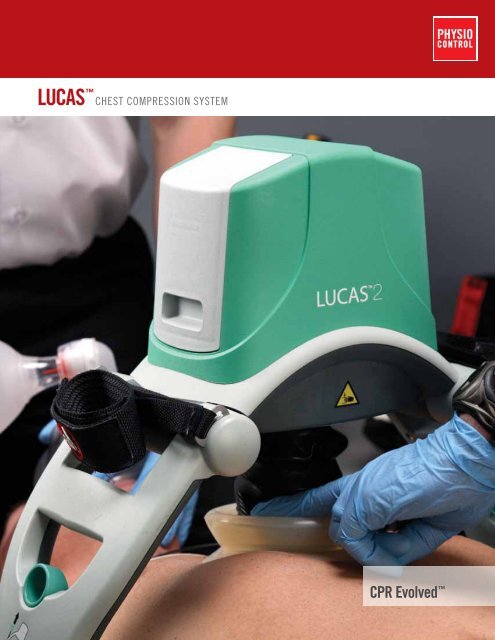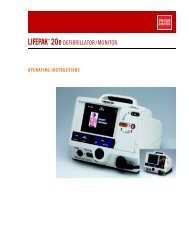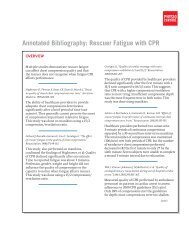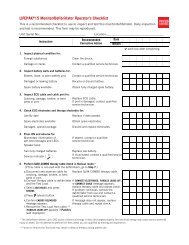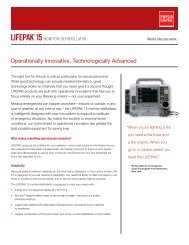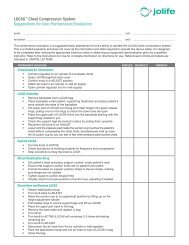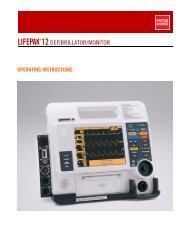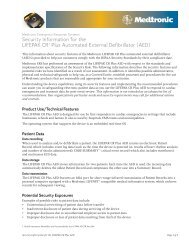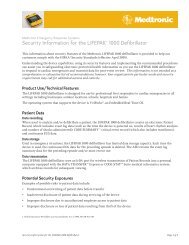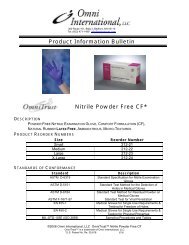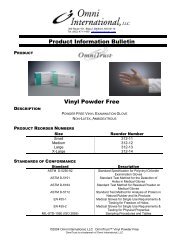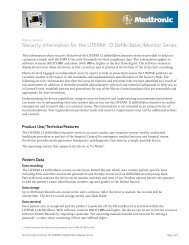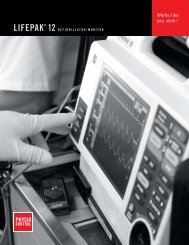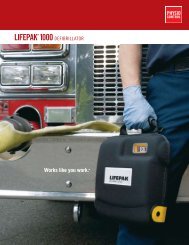LUCAS Chest Compression Brochure and Data Sheet - Physio Control
LUCAS Chest Compression Brochure and Data Sheet - Physio Control
LUCAS Chest Compression Brochure and Data Sheet - Physio Control
- No tags were found...
You also want an ePaper? Increase the reach of your titles
YUMPU automatically turns print PDFs into web optimized ePapers that Google loves.
<strong>LUCAS</strong> CHEST COMPRESSION SYSTEMCPR Evolved
Your partner in life supportEffective <strong>Compression</strong>s, Good Blood Flow Lead to Lifesaving CPREffective chest compressions deliver vital oxygen to the brain <strong>and</strong> can primethe heart for a successful shock. Maintaining sufficient coronary perfusionpressure during cardiac arrest improves the likelihood of return of spontaneouscirculation (ROSC). 1However, as any rescuer or caregiver knows, performing manual CPR according tocurrent AHA guidelines is difficult <strong>and</strong> tiring. In fact, many organizations have addedextra staff to cardiac arrest calls to switch out rescuers performing compressions.The <strong>LUCAS</strong> <strong>Chest</strong> <strong>Compression</strong> System is designedto deliver uninterrupted compressions at a consistentrate <strong>and</strong> depth to facilitate ROSC. It delivers automatedcompressions from first response in the field toambulance transport <strong>and</strong> throughout the hospital.<strong>LUCAS</strong> facilitates consistent blood flow from themoment it is turned on, helping to improve a patient’schance for a successful outcome.
“It’s simple <strong>and</strong> easy to use, <strong>and</strong> it’s small <strong>and</strong> compact.”— Dr. Charles Lick, Medical Director, Allina Medical TransportationIncreasing opportunities for improved outcomesEffective, consistent <strong>and</strong> uninterrupted compressions according to current AHA guidelines<strong>LUCAS</strong> is a portable, easy-to-use device that delivers automated, guidelines-consistent chest compressionsto improve blood flow in victims of cardiac arrest. <strong>LUCAS</strong> performs at a rate of 100 compressions per minutewith a depth of 1.5 to 2 inches. It also allows for complete chest wall recoil after each compression <strong>and</strong>provides a 50% duty cycle—equal compression <strong>and</strong> relaxation time for the chest wall.Maintain good blood flowSeveral studies show the effectiveness of manual chest compressions can drop rapidly—often after onlyone minute—due to rescuer fatigue. 2,3With <strong>LUCAS</strong>, automated compressions are delivered consistently<strong>and</strong> continuously, helping to maintain good circulation to the patient during transport <strong>and</strong> throughoutthe hospital.Increasing operational effectivenessEasy to use <strong>and</strong> efficient to own<strong>LUCAS</strong> is lightweight, comes in a backpack <strong>and</strong> can be applied quickly to a patient, interrupting manualcompressions for less than 20 seconds. It’s simple to apply whether the patient is on the ground, on a bedor on a stretcher in the ambulance. Your purchase includes a unique, multi-year service offering, keepingany maintenance expenses to a minimum.Keep personnel safe during CPRWhether you are delivering chest compressions in the back of an ambulance or in an emergency department,<strong>LUCAS</strong> can help keep responders safe. In a mobile environment, rescuers can be safely seat-belted in theback of an ambulance while <strong>LUCAS</strong> delivers compressions. In a hospital environment, <strong>LUCAS</strong> may helpdecrease occurrences of back injuries sustained while delivering CPR, as rescuers will no longer have todeliver prolonged CPR on a bed.In a study found in Resuscitation, of 205 respondents, over 80% experienced back discomfort; 56%felt the discomfort was related to the duration of CPR. 20% suffered back injury or prolapsed disc;40% considered their back injury related to/aggravated by CPR.Jones A. Can cardiopulmonary resuscitation injure the back? Resuscitation. 2004;61(1):63-67.
A tireless lifesaverWhen Leon Schmidt, 68, suffered a massive cardiac arrest, it was <strong>LUCAS</strong> that kept him alive. “As soon asthe paramedics arrived, they had Leon on the <strong>LUCAS</strong>,” recalls Gayle Schmidt, Leon’s wife. Later, Gayle wastold that patients who experience the same type of cardiac arrest as her husb<strong>and</strong> have only a three percentsurvival rate.“If it wasn’t for the <strong>LUCAS</strong>,” she insists, “Leon wouldn’t be with us today.”Results like this are encouraging to Charles Lick, MD, medical director for Allina Medical Transportation <strong>and</strong>Emergency Department director for Buffalo Hospital.“In 2005, the AHA determined that we need to focus on performing better chest compressions to movethe blood around <strong>and</strong> keep the organs working. We know that CPR is difficult to do well. People slowdown. They don’t always do it appropriately—even professional rescuers. A machine doesn’t get tired; it isconsistent, <strong>and</strong> consistency is key,” he explained.All Allina Medical Transportation ambulances are equipped with the lifesaving devices. And now BuffaloHospital has added a <strong>LUCAS</strong> device to its Emergency Department.“Someone who has suffered a sudden cardiac arrest in the field has a good chance of suffering another oneas we work on them in the Emergency Department,” Lick said.“The <strong>LUCAS</strong> is as valuable here as it is in the field.” Lick predicts that in the coming months, <strong>LUCAS</strong> will helpmore patients like Schmidt get on with their lives. “I’m convinced we can do much better CPR with <strong>LUCAS</strong>than we can with human intervention.”— To read other stories about <strong>LUCAS</strong> in action, go to www.physio-control.com/<strong>LUCAS</strong>
In a recent survey, nearly 25% of ambulance officers suffered back injury,<strong>and</strong> as many as 62% of these reported that the cause of the injury was relatedto CPR delivery.— Jones A, Lee R. Cardiopulmonary resuscitation <strong>and</strong> back injury in ambulance officers.International Archives of Occupational <strong>and</strong> Environmental Health. 2005;78(4):332-336.Improving operations in the fieldChiefs, training officers <strong>and</strong> medics are always looking for ways to maximize their resources whileimproving response in the field. Having <strong>LUCAS</strong> at your side during a cardiac emergency allows you toreduce the number of EMTs or firefighters to assist with CPR. This lessens chaos on the scene <strong>and</strong> freesup equipment <strong>and</strong> staff to go on to other emergencies.When the cardiac arrest victim is ready for transport, <strong>LUCAS</strong> moves with the patient from the emergencyscene to the ambulance. <strong>LUCAS</strong> provides continuous, effective compressions, helping to maintain goodcirculation in the patient while medics remain seat-belted for better safety in a mobile environment.CPR is difficult to do well. Manual CPR training can help <strong>and</strong> it’s expensive <strong>and</strong> cumbersome to schedule<strong>and</strong> track. <strong>LUCAS</strong> is simple <strong>and</strong> easy to use with minimal training, keeping the cost of ownership low.A vital tool for the clinically progressive agencyMedical directors know the value of quality CPR in achieving optimal clinical outcomes. With <strong>LUCAS</strong>,you can be confident that chest compressions are delivered according to the guidelines. By ensuringcompressions continue uninterrupted at a consistent depth to facilitate ROSC, your teams are able to helppatients to be more viable c<strong>and</strong>idates for recovery.<strong>LUCAS</strong> can be part of a clinically progressive resuscitation program. It works in t<strong>and</strong>em with coolingtherapies or impedance threshold devices for a comprehensive approach to patient resuscitation.
“The mood in the cath lab was calm at all times despite the ongoing VF. This is quite contraryto what usually happens in such situations when manual compressions are used.”— Olivecrona, Lund, Sweden, (tctmd.com 24 Oct 2006)Provide continuous care in the emergency departmentFor an emergency department or nurse manager, <strong>LUCAS</strong> is a vital tool in the treatment of cardiac arrestpatients. <strong>LUCAS</strong> delivers effective, consistent, uninterrupted chest compressions <strong>and</strong> can help effectivelymanage the code scene while helping the patient to maintain good circulation. Emergency department staff,relieved of the need to perform manual compressions, can more efficiently assess the patient’s condition<strong>and</strong> determine the best treatment plan. This can reduce crowding <strong>and</strong> chaos in the emergency department,which can help to maintain calm <strong>and</strong> focus amongst the staff, <strong>and</strong> potentially free up resources for use inother emergencies.Using <strong>LUCAS</strong> in the emergency department can help maintain coronary perfusion pressure withoutinterruption which is crucial to improving patient outcomes.Keep up the pressure in the cath labIn the event of cardiac arrest due to refractory ventricular fibrillation or a nonshockable rhythm, <strong>LUCAS</strong>enables the intervention to continue by providing consistent, guidelines-quality chest compressions, whichfacilitates blood circulation to supply oxygen to vital organs. In addition, <strong>LUCAS</strong> creates a less stressfulenvironment that enables quality decision making <strong>and</strong> keeps staff safely out of the x-ray field.<strong>LUCAS</strong> is mainly radio translucent, except for the hood <strong>and</strong> piston, enabling you to capture mostfluoroscopy projections without removing <strong>LUCAS</strong>. The following fluoroscopy projections can be capturedin monoplane while <strong>LUCAS</strong> is attached to the patient: LAO Cranial/Caudal Oblique; RAO Cranial/CaudalOblique; Straight Caudal; Straight Lateral; <strong>and</strong> Straight Cranial.
<strong>LUCAS</strong> CHEST COMPRESSION SYSTEM<strong>LUCAS</strong> 2Your choiceof two models:Battery Powered<strong>LUCAS</strong> 1Air Powered
Operation PanelBatteryPatient StrapRelease RingSuction Cup withPressure PadStabilization StrapBackboard<strong>LUCAS</strong> 2 model shown
“If I had one arm, <strong>and</strong> could only grabone thing to take into the house, it wouldbe <strong>LUCAS</strong>.”- Paramedic <strong>and</strong> Field Supervisor, Cypress CreekInclusive service package helpslower the cost of ownershipThe <strong>LUCAS</strong> <strong>Chest</strong> <strong>Compression</strong> System is delivered ready forimmediate use. The Silver Extended Service Plan provides two yearsof coverage after the end of the manufacturer’s one-year warranty, fora total of three years of support. The Silver Extended Service Plan isincluded with the purchase of the <strong>LUCAS</strong> <strong>Chest</strong> <strong>Compression</strong> System.An upgrade to the Gold Extended Service Plan provides enhancedservices such as scheduled performance inspections, loanerequipment, extended coverage for parts <strong>and</strong> labor, <strong>and</strong> replacement ofunserviceable equipment.<strong>LUCAS</strong> is maintained by the same <strong>Physio</strong>-<strong>Control</strong> service team thathas been a part of our company’s framework since 1972. Our servicerepresentatives have an average tenure of over 12 years <strong>and</strong> logan average of 1,600 field hours each year. With <strong>Physio</strong>-<strong>Control</strong> onyour side, your equipment is backed by stellar support, so you getmaximum life <strong>and</strong> use from your investment.
Specifications<strong>LUCAS</strong> 1CHEST COMPRESSION SYSTEM<strong>LUCAS</strong> 2CHEST COMPRESSION SYSTEMCOMPRESSIONS<strong>Compression</strong> Frequency: 100 compressions per minute<strong>Compression</strong> Depth: 2 inches (5 cm)<strong>Compression</strong>/Decompression Duty Cycle: 50%Patients Eligible for Treatment:• Sternum height of 7.5 – 11.9 inches (19 – 30.3 cm)• Maximum sternum width of 17.7 inches (45 cm)OPERATIONOperation: Fully pneumatic (compressed air)Power Source:• Breathing air from portable compressed air cylinder• Air outlet in hospital/ambulance with nominal supply pressure within 46–87 psi (3.17– 6 bar)Air Consumption: 1.84 ft 3 per minute (52 L/minute)Operating Temperature: 41 to 104°F (5 to 40°C)Storage Temperature: -22 to 140°F (-30 to 60°C)PHYSICAL CHARACTERISTICSHeight (stowed in backpack): 25.6 inches (65 cm)Width (stowed in backpack): 13 inches (33 cm)Depth (stowed in backpack): 9.8 inches (25 cm)Air hose length: 10.8 feet (3.3 meters)Weight (unit only): 13.9 lbs (6.3 kg)Weight (backpack <strong>and</strong> included accessories): 5 lbs (2.27 kg)COMPRESSIONS<strong>Compression</strong> Frequency: 100 ± 5 compressions per minute<strong>Compression</strong> Depth: 1.5 to 2 inches (4-5cm )<strong>Compression</strong>/Decompression Duty Cycle: 50 ± 5%Patients Eligible for Treatment:• Sternum height of 6.7–11.9 inches (17 – 30.3 cm)• Maximum chest width: 17.7 inches (45 cm)The use of <strong>LUCAS</strong> is not restricted by patient weightOPERATIONOperation: ElectricalPower Source: Battery — Rechargeable Lithium-ion Polymer (LiPo)• Size: 5.1 x 3.5 x 2.2 inches (13.0 x 8.8 x 5.7 cm)• Weight: 1.3 lbs (0.6 kg)• Capacity: 3300 mAh (typical), 86 Wh• Battery voltage: 25.9 V• Run time: 45 minutes (typical)• Maximum battery charge time: Less than 4 hours at room temperature (72°F/ 22°C)• Required interval for replacement of battery: Recommendation to replace batteryevery 3 years or after 200 usesBattery Environmental Specifications• Operating temperature: 32°F to 104°F / 0°C to +40°C• Charge temperature: 41°F to 95°F / 5°C to +35°C• Storage temperature: 32°F to 104°F/ 0°C to 40°C for
<strong>Physio</strong>-<strong>Control</strong> Products <strong>and</strong> SolutionsExperience the legendary quality that has madeLIFEPAK products <strong>and</strong> services the clear favoritearound the world.As your trusted partner in saving lives, we offer a full suiteof solutions from field to hospital, whether your need isemergency response or quality control analysis.LIFEPAK ® Defibrillators/MonitorsLIFEPAK 15 Monitor/DefibrillatorThe LIFEPAK 15 monitor/defibrillator is the new st<strong>and</strong>ard in emergencycare for ALS teams who want the most clinically innovative, operationallyinnovative <strong>and</strong> LIFEPAK TOUGH device available today. The 15integrates Masimo Rainbow SET ® technology that monitors SpO 2 ,Carbon Monoxide <strong>and</strong> Methemoglobin, includes a metronome toguide CPR compressions <strong>and</strong> ventilations <strong>and</strong> provides an option toescalate energy to 360J. An entirely new platform, the 15 is poweredby Lithium-ion battery technology, incorporates the SunVue displayscreen for viewability in bright sunlight, <strong>and</strong> data connectivity to easily<strong>and</strong> securely collect <strong>and</strong> send patient information. Similar form factor<strong>and</strong> user interface with the LIFEPAK 12 defibrillator/monitor will easetransition <strong>and</strong> training costs.LIFEPAK 12 Defibrillator/MonitorOver 80,000 LIFEPAK 12 defibrillator/monitors are in use today—on rescue rigs <strong>and</strong> in hospitals worldwide. Feedback from this globalcommunity keeps us innovating—adding features to help you in yourlifesaving work. The LIFEPAK 12 defibrillator/monitor packs multiparametertherapeutic <strong>and</strong> diagnostic functions into a rugged, portabledevice. Use a tool that can tackle today’s patient care needs <strong>and</strong> adaptto tomorrow’s challenges.
LIFEPAK 20e Defibrillator/MonitorBuilding on the design of its predecessor, the LIFEPAK 20e defibrillator/monitor is compact, lightweight <strong>and</strong> easy to rush to the scene oruse during transport. The 20e is highly intuitive to use, putting early,effective defibrillation into the h<strong>and</strong>s of first responders. The 20eskillfully combines AED function with manual capability so that ACLStrainedclinicians can quickly <strong>and</strong> easily deliver advanced diagnostic<strong>and</strong> therapeutic care. Clinically advanced <strong>and</strong> packed with power,the 20e uses Lithium-ion battery technology that provides extendedoperating time for transporting patients from one area of the hospital toanother <strong>and</strong> includes ADAPTIV biphasic technology up to 360 joules.LIFEPAK 1000 DefibrillatorThe 1000 is a powerful <strong>and</strong> compact device designed to treat cardiacarrest patients <strong>and</strong> provide continuous cardiac monitoring capabilities.Built-in flexibility allows the 1000 to be programmed for use by firstresponders or professionals <strong>and</strong> enables care providers to changeprotocols as st<strong>and</strong>ards of care evolve. A large, intuitive screen displaysgraphics <strong>and</strong> ECG readings that are clear <strong>and</strong> easy to read from adistance. The most rugged defibrillator in the LIFEPAK fleet, you cancarry the 1000 with confidence into the harshest environments.LIFEPAK CR ®Plus Automated External DefibrillatorDesigned for minimally trained rescuers in commercial <strong>and</strong> publicsettings, the CR Plus guides the rescuer step by step with calm,clear voice prompts. Simple to use, it is built with the same advanceddefibrillation technology used by EMS <strong>and</strong> hospital personnel.LIFENET ® SystemLIFENET SystemThe LIFENET System provides EMS <strong>and</strong> hospital care teams withreliable, quick access to clinical information helping to improve patientcare flow <strong>and</strong> operational efficiency. The LIFENET System providescustomers with a reliable <strong>and</strong> secure web-based platform linking careteams with critical information for emergent patient data <strong>and</strong> post-eventreview. From providing an advanced alert of an incoming patient, toreviewing post event data, to tracking assets, the LIFENET System isthe most comprehensive system on the market today.
For more than 50 years, <strong>Physio</strong>-<strong>Control</strong>, maker of the renownedLIFEPAK defibrillators, has been developing technologies <strong>and</strong> designingdevices that are legendary among first response professionals, clinicalcare providers <strong>and</strong> the community.REFERENCES1 Paradis N, Martin G, Rivers E, et al. Coronary perfusion pressure <strong>and</strong> the return of spontaneous circulation in human cardiopulmonaryresuscitation. JAMA 1990;263(8):1106-1112.2 Ochoa FJ, Ramalle-Gómara E, Lisa V, Saralegui I. The effect of rescuer fatigue on the quality of chest compressions. Resuscitation.1998;37:149-52.3 Hightower D, Thomas S, Stone C, Dunn K, March J. Decay in quality of closed-chest compressions over time. Annals of Emergency Medicine.1995;26:300-303.<strong>LUCAS</strong> is designed <strong>and</strong> manufactured by JOLIFE AB in Sweden <strong>and</strong> distributed worldwide by <strong>Physio</strong>-<strong>Control</strong>, Inc.All information including comparative statements are valid as of June 2009.For For further further information, please please contact contact your your local local <strong>Physio</strong>-<strong>Control</strong> <strong>Physio</strong>-<strong>Control</strong> representative representative or or visit visit www.physio-control.comour website at www.physio-control.comHEADQUARTERS<strong>Physio</strong>-<strong>Control</strong>, Inc.11811 Willows Road NEP. O. Box 97006Redmond, WA 98073-9706 USATel. 425 867 4000Toll Free. 800 442 1142Fax. 425 867 4121www.physio-control.comSALES OFFICES<strong>Physio</strong>-<strong>Control</strong> UKMedtronic LtdSuite One, Sherbourne HouseCroxley Business ParkWatford, HertsWD18 8WWTel. 44 1923 212 213Fax. 44 1923 241 004CanadaMedtronic of Canada6733 Kitimat RoadMississauga, ONL5N 1W3Tel. 888 879 0977Fax. 416 430 6115©2009 <strong>Physio</strong>-<strong>Control</strong>, Inc. All rights reserved. All names mentioned herein are trademarks or registered trademarks of their respective owners.Specifications subject to change without notice.GDR 3303294_A


